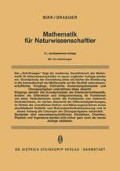Zusammenfassung
Bei der Exponentialfunktion tritt das Argument x als Exponent auf. Wir können die Exponentialfunktion also in der Form
ansetzen, wobei unter a eine Konstante zu verstehen ist. Es ist klar, daß wir dabei a = 1 ausnehmen, weil das einen trivialen Sonderfall ergäbe. Auch negative Werte von a müssen wir ausschließen; denn setzen wir beispielsweise a = - 2, so ist für
und zu x = 1/2 gehört überhaupt kein reelles y, weil Inline 1\( y(t) \approx \overline {y\left( {kT} \right)} \) ist.

Access this chapter
Tax calculation will be finalised at checkout
Purchases are for personal use only
Preview
Unable to display preview. Download preview PDF.
Author information
Authors and Affiliations
Rights and permissions
Copyright information
© 1971 Theodor Steinkopff, Dresden
About this chapter
Cite this chapter
Sirk, H., Draeger, M. (1971). Elementare Funktionen. In: Mathematik für Naturwissenschaftler. Steinkopff. https://doi.org/10.1007/978-3-642-72302-5_4
Download citation
DOI: https://doi.org/10.1007/978-3-642-72302-5_4
Publisher Name: Steinkopff
Print ISBN: 978-3-7985-0338-0
Online ISBN: 978-3-642-72302-5
eBook Packages: Springer Book Archive

